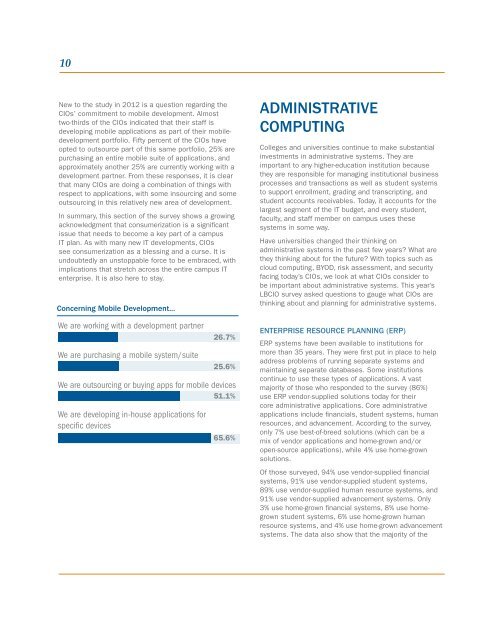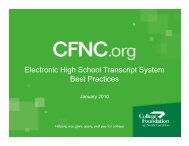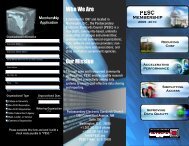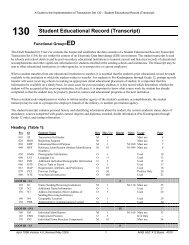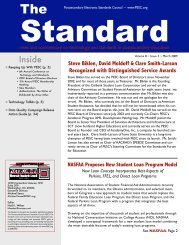February 2013 - PESC
February 2013 - PESC
February 2013 - PESC
You also want an ePaper? Increase the reach of your titles
YUMPU automatically turns print PDFs into web optimized ePapers that Google loves.
10<br />
New to the study in 2012 is a question regarding the<br />
CIOs’ commitment to mobile development. Almost<br />
two-thirds of the CIOs indicated that their staff is<br />
developing mobile applications as part of their mobiledevelopment<br />
portfolio. Fifty percent of the CIOs have<br />
opted to outsource part of this same portfolio, 25% are<br />
purchasing an entire mobile suite of applications, and<br />
approximately another 25% are currently working with a<br />
development partner. From these responses, it is clear<br />
that many CIOs are doing a combination of things with<br />
respect to applications, with some insourcing and some<br />
outsourcing in this relatively new area of development.<br />
In summary, this section of the survey shows a growing<br />
acknowledgment that consumerization is a significant<br />
issue that needs to become a key part of a campus<br />
IT plan. As with many new IT developments, CIOs<br />
see consumerization as a blessing and a curse. It is<br />
undoubtedly an unstoppable force to be embraced, with<br />
implications that stretch across the entire campus IT<br />
enterprise. It is also here to stay.<br />
Concerning Mobile Development...<br />
We are working with a development partner<br />
We are purchasing a mobile system/suite<br />
We are outsourcing or buying apps for mobile devices<br />
51.1%<br />
We are developing in-house applications for<br />
specific devices<br />
26.7%<br />
25.6%<br />
65.6%<br />
Administrative<br />
Computing<br />
Colleges and universities continue to make substantial<br />
investments in administrative systems. They are<br />
important to any higher-education institution because<br />
they are responsible for managing institutional business<br />
processes and transactions as well as student systems<br />
to support enrollment, grading and transcripting, and<br />
student accounts receivables. Today, it accounts for the<br />
largest segment of the IT budget, and every student,<br />
faculty, and staff member on campus uses these<br />
systems in some way.<br />
Have universities changed their thinking on<br />
administrative systems in the past few years? What are<br />
they thinking about for the future? With topics such as<br />
cloud computing, BYOD, risk assessment, and security<br />
facing today’s CIOs, we look at what CIOs consider to<br />
be important about administrative systems. This year’s<br />
LBCIO survey asked questions to gauge what CIOs are<br />
thinking about and planning for administrative systems.<br />
Enterprise resource planning (ERP)<br />
ERP systems have been available to institutions for<br />
more than 35 years. They were first put in place to help<br />
address problems of running separate systems and<br />
maintaining separate databases. Some institutions<br />
continue to use these types of applications. A vast<br />
majority of those who responded to the survey (86%)<br />
use ERP vendor-supplied solutions today for their<br />
core administrative applications. Core administrative<br />
applications include financials, student systems, human<br />
resources, and advancement. According to the survey,<br />
only 7% use best-of-breed solutions (which can be a<br />
mix of vendor applications and home-grown and/or<br />
open-source applications), while 4% use home-grown<br />
solutions.<br />
Of those surveyed, 94% use vendor-supplied financial<br />
systems, 91% use vendor-supplied student systems,<br />
89% use vendor-supplied human resource systems, and<br />
91% use vendor-supplied advancement systems. Only<br />
3% use home-grown financial systems, 8% use homegrown<br />
student systems, 6% use home-grown human<br />
resource systems, and 4% use home-grown advancement<br />
systems. The data also show that the majority of the


